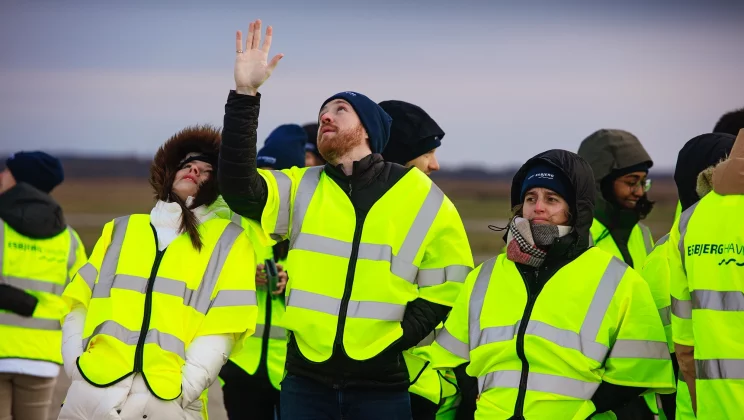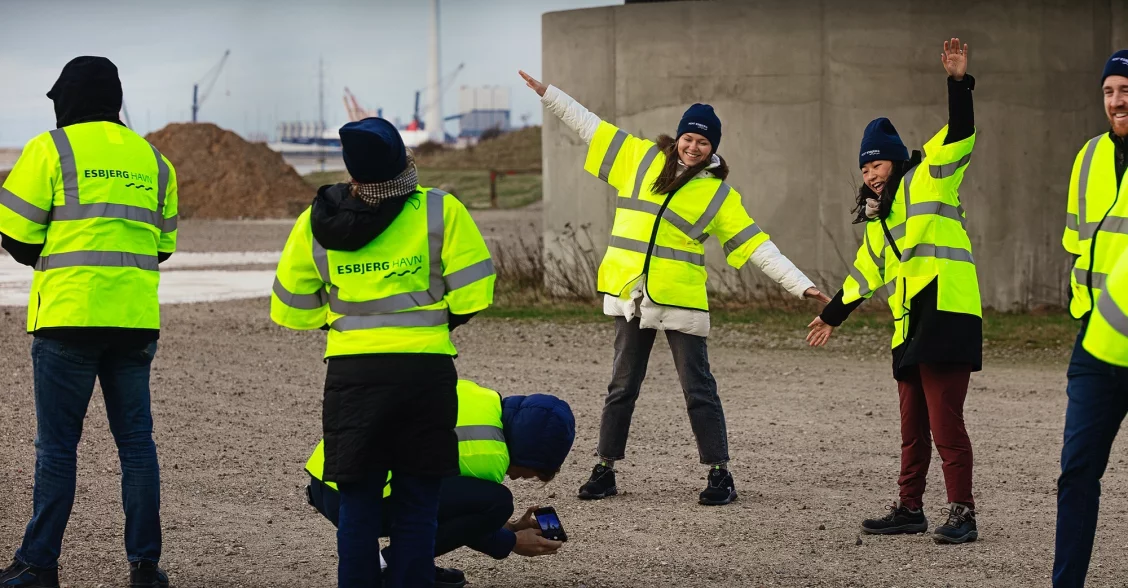Again this year, as part of Port Esbjerg’s collaboration with Harvard Business School, a group of MBA students were given a tour of the port to see how the green transition works in practice. The students were impressed by the Måde Wind Test Centre, INEOS, TotalEnergies and the DIN Forsyning utility company.
Whoosh. Whoosh. Whoosh. That is the sound of the 92-metre blades high above where 45 Harvard students visiting Esbjerg are standing during a January storm.
”The sound of green transition,” as a student noted with a smile as she was looking up at the 9.4 MW Måde turbine, which only four years ago was the world’s largest of its kind, but whose size has now been surpassed several times. This is a concrete example of how fast things change at Port Esbjerg.
A group of 45 MBA students from the Harvard Business School visited Port Esbjerg on a field trip to see how the green transition is unfolding in practise.
”You have come to the right place, because Port Esbjerg has been involved in more than two thirds of all offshore wind installed in Europe,” Jesper Bank, CCO at Port Esbjerg, told the group.
Professor Willy Shih of Harvard Business School pointed out that the visit was arranged to give the students a chance to experience the world that awaits Americans in the future, because this is an area where Denmark and Europe are both ahead of the US.
”We come to Denmark to look into the future. When we talk to INEOS, TotalEnergies and DIN forsyning, we meet some of the frontrunners worldwide,” he says.
It was Professor Shih’s decision that the field trip would be to Denmark and to Esbjerg to give the students a source of inspiration as part of their two-year programme.
Storing carbon underground
On a tour of the port, the students passed 102 Siemens nacelles, each weighing 500 tonnes. They were sitting at a site in the harbour area, ready to form part of a German project scheduled for installation later this year and next to 98-metre blades for the same project, which left everyone on the bus quite impressed.
Other turbine parts at the harbour were to be shipped to as far away places as Taiwan and the United States.
A new gigantic warehouse will be used for assembling the wind turbines of the future, which are considerably larger than today’s turbines. The new turbine parts are so immensely heavy that it is necessary to drive piles into the ground to build the specially-designed foundation required.
At INEOS, senior project manager Christian K. Christensen explained about the Greensand pilot project, where carbon will be captured and stored in depleted oil wells. This is a concept, INEOS will try to commercialise over the next couple of years.
”By storing it, we hope to reduce CO2 emissions by 92.5 percent, and we could potentially store eight million tonnes annually,” he said.
At the DIN forsyning utility company, project manager Kenneth Jorgensen explained about their new seawater heat pump, which to their knowledge is the only one in the world of its size.
Using CO2 as a refrigerant, the pump marks a crucial breakthrough for the future of district heating and temperature control throughout the district heating network.
Esbjerg’s geographical location by the sea provides an ideal opportunity to use energy from the sea, and the pump draws the heat from the sea water and heats up the district heating water to the desired temperature before it is fed to customers in the local area.
Professor Shih found that fascinating.
“I'm really impressed. I think this is the only one of its kind in the world. At least, I have never seen one before,” he said, nodding appreciatively.

The 45 MBA students from Harvard were very impressed to see the green transition in practice.
TotalEnergies is now a multi-energy company
To many people, when they think of multi-energy company TotalEnergies, they think of oil and gas, and the company has more than 100,000 employees in 130 countries. However, Betina Jørgensen, Head of Renewables, Business Development Denmark, told the 45 Harvard students that TotalEnergies now considers itself one of the world’s leading multi-energy companies.
”Today, we have 22 GW of green energy ’in operation’ within solar and wind. That’s more than Ørsted,” she explained, before adding:
“And that is just the beginning.”
There are tenders for a total of 9 GW wind underway in Denmark, and among the many areas it is involved in, TotalEnergies is engaged in the conversion of electricity to hydrogen.
“We have made many different attempts to contribute to the green transition. We believe that oil and gas will still be needed in 2050, but by that time TotalEnergies will be in a much different place than we are today,” explained Betina Jørgensen.
Today, TotalEnergies generate about eight percent of their energy production from green energy and the company aims to be net zero by 2050. They are already the global leader in solar energy and will be a market leader in green energy by 2030.
”We have a responsibility as a producer of energy, and many of our colleagues are working in product management, operations, construction, etc. So we have a responsibility as well as opportunities,” says Betina Jørgensen.
See more from the day at the port and how the students benefited from the visit:
Inspiring and fascinating
The MBA programme at Harvard Business School is a two-year graduate programme, where the students have an average of five years of prior work experience. The trip to Esbjerg falls during the second year of their programme and is intended to give them an impression of how the green transition occurs in practice.
One of the students is Liz Gelb, and she finds the visit to Esbjerg Harbour very inspiring.
”Everything here is fascinating. I have spent most of my career in emerging markets doing really preliminary planning and master planning, so to see examples of a best-in-class projects like this is really inspiring. We have seen so many aspects of the green transition; CCS, carbon capture, district heating, and the massive wind turbines, which I find beautiful and majestic. I’m super appreciative and find it very inspiring,” she said.
For Port Esbjerg, this is also a beneficial collaboration, which both acts as recognition of the port’s position while also providing specific benefits.
”We exchange knowledge, share ideas and follow up in our dialogue with Professor Shih afterwards. Our aim is to professionalise the entire process of the green transition and to drive innovation, development and trade,” says Dennis Jul Pedersen, CEO at Port Esbjerg.
Jutland as a green powerhouse
In addition to seeing Port Esbjerg, the students from Harvard Business School also visited Vestas. Professor Shih, who organised the field trip to Esbjerg, believes that Jutland as a whole is a green powerhouse that stands out even for a Harvard professor.
“Esbjerg and the rest of Jutland is a unique, green cluster, and today has been a huge experience for our students,” he says.
”When I go back to the US, I will have knowledge that I can use in the process that we are about to embark on in the US.”
Go to overview

